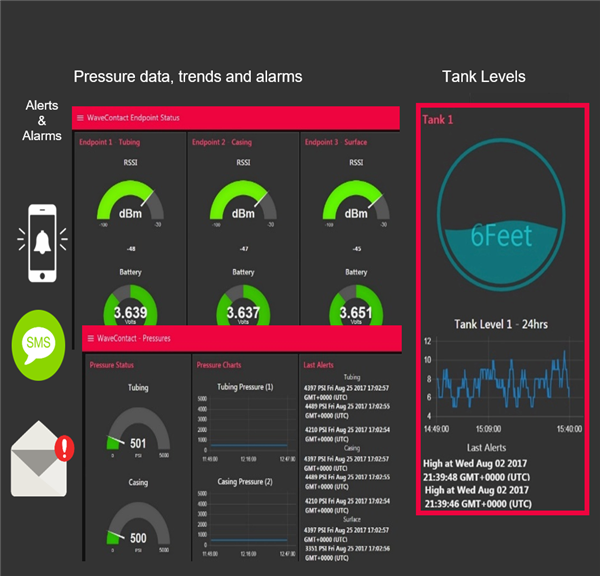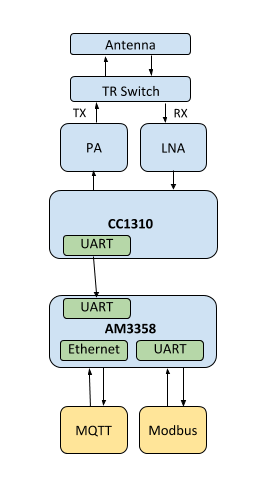SSZT710 may 2018 AM3358 , CC1310 , CC1350
Oil production fields have a large number of wellheads scattered over a wide area. These wellheads require regular monitoring to ensure that the equipment is in good working order and to avoid the potential for breakdowns or oil spills. Traditionally, this monitoring has been labor-intensive; workers must drive around the field to check sensor values and equipment. Not only is this time-consuming and expensive, but workers may occasionally be exposed to hazardous situations if problems occur.
Although the latest generation of oil-field equipment often includes remote monitoring capabilities, many oil fields have capital equipment that is older and very expensive to replace. FreeWave, a leading vendor of wireless Industrial Internet of Things (IIoT) solutions, provides the ability to retrofit remote monitoring into existing capital equipment deployments, thereby reducing operational expenses and increasing worker safety. FreeWave achieves this through its Amazon Web Services (AWS)-based ZumIQTM Application Environment software (which enables remote, browser-based monitoring) and its ZumLink long-range radios, which are based on TI’s SimpleLink™ CC1310/CC1350 wireless microcontrollers (MCUs) and Sitara™ AM3358 processor. In this blog post, we will look at how FreeWave used AWS services and TI devices to deliver products that address their users’ needs.
900MHz ZumLink series Z9-PE radio
 Figure 1 ZumIQ Dashboard
Figure 1 ZumIQ DashboardTI’s CC1310 wireless MCU and AM3358 processor enabled FreeWave to achieve the necessary processing performance within its power budget, as well as a wireless link to accommodate the future bandwidth needed for IIOT applications. Since FreeWave’s equipment typically operates in harsh environments, TI’s commitment to industrial-grade devices was also important.
To achieve the long range required, FreeWave needed to use the industrial-scientific-medical (ISM) band 915MHz radio. FreeWave selected the SimpleLink CC1310 wireless MCU for its ZumLink product line. The CC1310 wireless MCU supports the Sub-1 GHz spectrum, including the 915MHz band. While the CC1310 wireless MCU’s very low power operation met FreeWave’s power-consumption goals, the CC13xx product roadmap matched well with their future product requirements. They are already incorporating the CC1350 wireless MCU, which offers dual-band Sub-1 GHz and 2.4GHz radios, into a new design for a 2.4GHz version of ZumLink. They then plan to use the multiband CC1352 wireless MCU to add 802.15.4-based protocols.
The combination of dual- and multiband wireless MCUs and the SimpleLink software development kit (SDK), which provides a compatible SDK across multiple wireless microcontrollers and radios, enables FreeWave to leverage a common software platform across multiple products, reducing development costs. FreeWave also benefited from TI’s IoT ecosystem partners, using the -6LoWPAN- protocol from ThingSquare’s Contiki OS to accelerate development of their software stack.
Aided by in-depth support from the CC13xx applications team, FreeWave leveraged its expertise in radio design to develop a custom protocol stack and create a product that offered up to 3.2Mbps transmission over a range of up to 20m. Using additional ZumLink radios in a repeater mode extends the range further to 200m.
TI’s Sitara AM3358 device is a 1GHz Arm® Cortex-A8-based processor that comes with a fully supported embedded Linux distribution. This combination provides a familiar and powerful programming environment to enable easy customization of ZumLink to integrate with pre-existing wellhead equipment. The AM3358 processor can support a broad range of industrial protocols, including Modbus, which enables the ZumLink radio to connect to a Modbus gateway at the wellhead.
The CC1310 wireless MCU functions as network processor and communicates to the AM3358 processor over a serial UART interface. FreeWave used the AM3358’s programmable real-time unit and industrial communication subsystem (PRU-ICSS) co-processor, which is optimized for the implementation of customized high-speed serial interfaces, to manage the interface between the AM3358 processor and the CC1310 wireless MCU (see Figure 2), as this interface requires serial communication of up to 3.2Mbps. The AM3358 processor also contains an on-chip Ethernet interface for connecting to the cellular gateway or directly into a wired network, if available.
 Figure 2 Communication Layout between the CC1310 Wireless MCU and the AM3358 Processor
Figure 2 Communication Layout between the CC1310 Wireless MCU and the AM3358 ProcessorAn important benefit of the Processor SDK Linux distribution for the AM3358 device was its support for OpenEmbedded/Yocto recipes. This enabled FreeWave to easily customize the distribution by adding both additional open-source packages and custom components associated with their radio.
ZumIQ Application Environment
Having seen the benefits of using AWS, FreeWave’s goal is to have all of its future radios be “AWS ready” so users can connect them to the cloud out of the box. The AM3358’s provision of a standard Linux platform will enable FreeWave to offer AWS Greengrass on the ZumLink, simplifying the addition of familiar cloud programming models, messaging, data caching, synchronization and machine-learning inference capabilities at the edge.
FreeWave is also developing another TI-based product using Amazon FreeRTOS to take advantage of IoT services on microcontrollers such as over-the-air (OTA), further reducing their code maintenance costs.
Designing an IoT application requires developers to work with more vendors than a traditional embedded design. TI works closely with AWS to ensure that companies like FreeWave can successfully deliver highly differentiated products.
Additional Resources
- Learn more about FreeWave’s wireless design and integration services or its ZumLink and ZumIQ products.
- To start developing your IoT own project with the CC13xx family, check out AWS sensor-to-cloud designs.
- Learn more about AWS IoT.
- Explore the Sitara processor family.